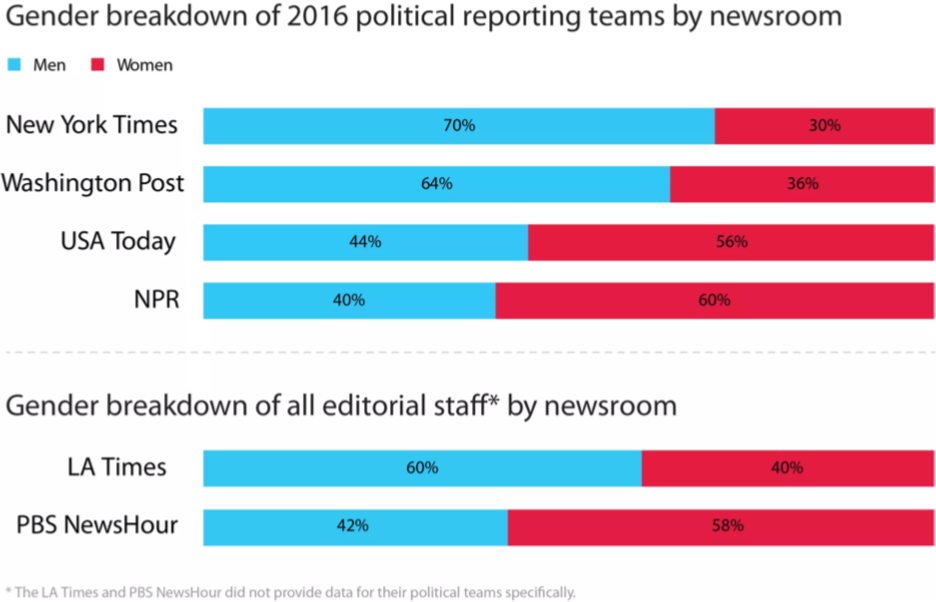When it comes to shining a light on their own hiring practices, many major newsrooms seem to be less forthcoming about the demographics of their staff, Joan Shorenstein Fellow Farai Chideya found in her new report on the state of diversity in American newsrooms, with a focus on the political press corps.
As part of her research, Chideya reached out to 15 news organizations asking for race and gender breakdowns, specifically of newsrooms’ 2016 political reporting teams. She only heard back from four of them with the data she’d requested: USA Today, The New York Times, NPR, and The Washington Post. BuzzFeed, which has disclosed its diversity numbers in previous years, didn’t provide data to Chideya. NBC instead provided diversity numbers for its parent company, Comcast. The Wall Street Journal and CBS declined to provide data.


Few were willing to put anyone on the record about staffing choices, with an exception: USA Today’s Washington Bureau chief Susan Page responded immediately to a request, and offered the publication’s managing editor for government and politics Lee Horwich for an interview:
“I think that 2020 is going to pose a huge challenge for political journalists,” Horwich said. “I think that it is vital that we have an understanding of the diversity of staff that we need to approach these problems. But not just that, regardless of race/gender/ethnicity of journalists, we need to be reflective of the diversity of the electorate and of the country as a whole, and explain and understand what those people are saying and demanding.” USA Today began assessing its 2020 staffing and editorial needs right after the election. “Four years seems like a long time. It isn’t.”
So what next steps can we as an industry take? Transparency on all levels is a necessary first step:
For instance, the Pulitzer, duPont and other major news prizes could require public disclosure of diversity metrics as a qualification for acceptance of the prize. This would broadly affect both the for-profit and the non-profit media outlets that compete for these awards.
Consider also turning investigative attentions more seriously to our own industry:
Newsroom discrimination settlements requiring nondisclosure agreements are an opportunity for investigative reporters to examine the fiscal and ethical practices of newsrooms. The work of New York Times reporter Emily Steel helped end the Fox News career of Bill O’Reilly, and reshaped Fox News after revealing it had paid tens of millions of dollars in settlements to women in his case and that of network chief Roger Ailes. Still, there has not yet been a major journalistic examination of payments by news outlets to settle cases involving race, ethnicity, age and sexual orientation.
Many individual journalists are doing the heavy lifting when it comes to building programs for other journalists of color. The demand for these opportunities is often overwhelming. The Ida B. Wells Society, co-founded by New York Times reporter Nikole Hannah-Jones, focuses specifically on mentorship and training for journalists of color, and saw more than 600 journalists signing up in its first month of existence:
“We intend to provide the type of high-quality mentoring and training that will make it impossible for newsrooms to say they cannot find qualified applicants,” Hannah-Jones said. “Within a few years, we hope to have a cohort of journalists that will allow us to call out these excuses because we will know there are qualified applicants — because we will have trained them ourselves.”
You can read Chideya’s full paper, which traces changed — and unchanged — American newsrooms in the fifty years since the Kerner Commission‘s 1968 report, here.
— The share of women in newsrooms has increased barely 1 percentage point since 2001, 2017 ASNE data showed. The share of non-white people working in American newsrooms is up just 2.9 percent since 2001.
— “News stories in Europe are predominantly by and about men. Even photograph sizes are unequal.”
— Two calls from 2017, for a different 2018: “Women of color will reclaim and monetize our time” and “Failing diversity is failing journalism.”